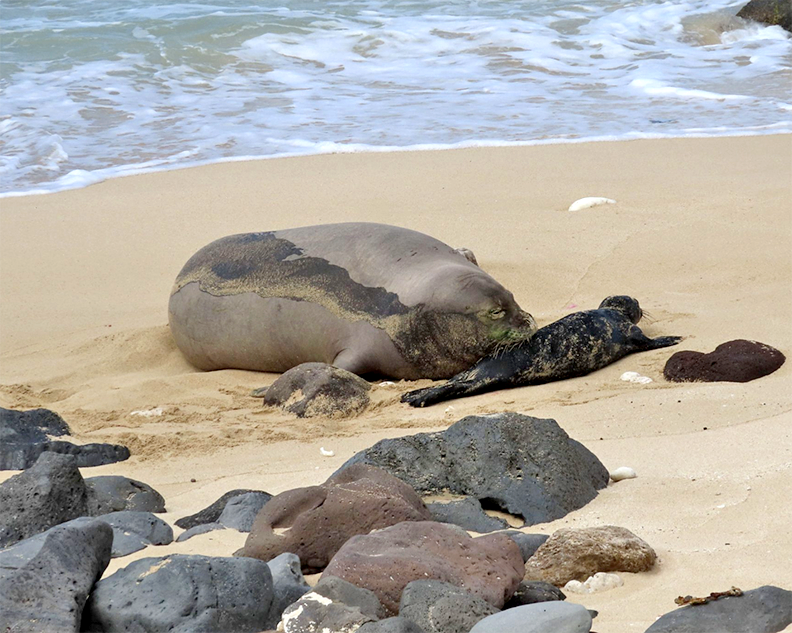
Pat Gmelin, KISC Mongoose Response Technician, with first confirmed mongoose on Kaua`i captured near Lihu`e Airport. Photo courtesy of KISC
Uh-Oh! Mongoose!
by Jan TenBruggencate
Kaua`i’s birdlife is different from that on the other islands—rich, diverse, sometimes noisy, colorful.
The trapping recently of a live mongoose could signal an end to that.
It’s difficult to imagine the impact of a mongoose invasion, but not too difficult. We have the example of the other mongoose-rich islands, where our island’s feathered diversity is unknown.
We have flocks of honking nene cruising overhead in several of our communities, often arranged in the classic goose-vee. Down at the Kaua`i Lagoons golf courses, there are so many nene that they’re threatening aircraft at Lihu`e Airport and are being moved away to other islands.
At ponds and streams and water hazards around the island, it’s not unusual to see red-faced Hawaiian stilts and white-faced Hawaiian coots. Even in Koke`e streams, you’ll come across koloa—Hawaiian ducks, sailing in for landings in the cool pools.
Nene, coots, gallinules, ducks and a couple of other ground-nesting water birds are all federally listed endangered species. We on Kaua`i have them in large numbers; no other island does.
Along the Kaua`i shore, wedge-tailed shearwaters navigate to nesting burrows and Laysan albatross to sprawling open nests. Up in the mountains, Newell’s shearwaters and Hawaiian petrels nest in ground colonies in the forest and on cliffs.
Mongooses were introduced to the Islands in the fall of 1883 by a sugar industry hoping they would curtail rat damage. Stories differ about how effective they were; it’s notable that mongooses come out in daylight and rats and night.
There are several stories about why they never were settled on Kaua`i. One: a mongoose in a cage at the harbor bit a dockworker, who kicked the cage into the sea, drowning the animals destined for this island.
But a new flurry of credible sightings, and the capture of a robust three-pound male near the fence around Lihu`e Airport, suggests mongooses have found their way to the island.
Keren Gunderson, of the Kaua`i Invasive Species Committee, said there are now credible sightings in several widespread parts of the island. At least one sighting in the Lihu`e area is of a pair of mongooses.
The animals eat most anything, from insects to fruit to bird eggs to geckos. They are also known to dig up turtle eggs in the sand. The one caught last month at the airport was trapped using coconut meat for bait.
Raymond Kramer’s book, Hawaiian Land Mammals says mongooses are well-known predators of poultry and seabirds. By 1938, he writes that thanks to mongooses, both the Newell’s shearwater and dark-rumped petrel were extinct on Molokai, and wedge-tailed shearwaters are essentially found only on Kaua`i and small offshore islands without mongoose populations.
There are reports that they will occupy seabird burrows and raise their young in them.
There are several species of mongoose. The one in Hawai`i is the small Indian or small Asian mongoose, Herpestes javanicus, sometimes called Herpestes auropunctatus. In Hawaiian it is manakuke or `iole manakuke.
If they have become established here, we will be a different place.

Jan TenBruggencate
Jan TenBruggencate is a beekeeper, an author and the former science writer for The Honolulu Advertiser. He operates a communications company, Island Strategy LLC. He serves on the board of the Kaua’i Island Utility Cooperative and on the County Charter Review Commission
Discover more from ForKauaiOnline
Subscribe to get the latest posts sent to your email.




Leave a Reply